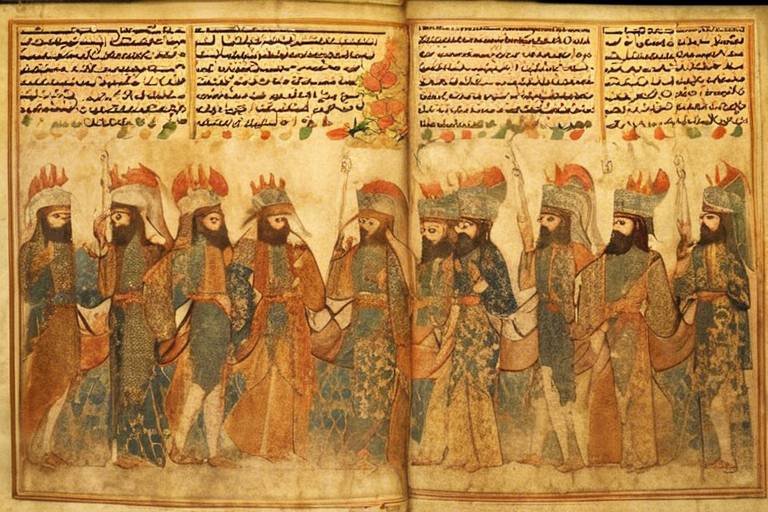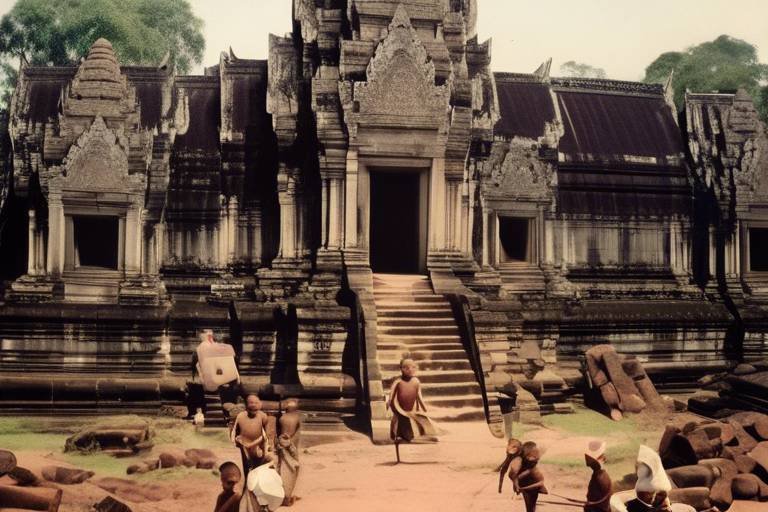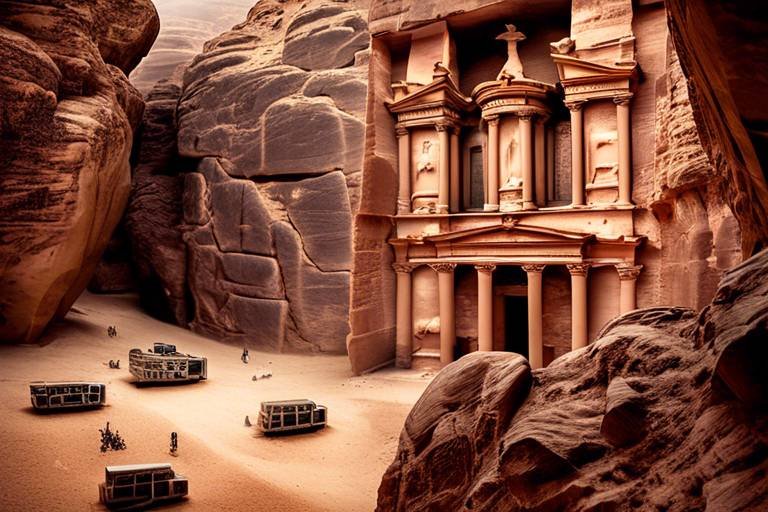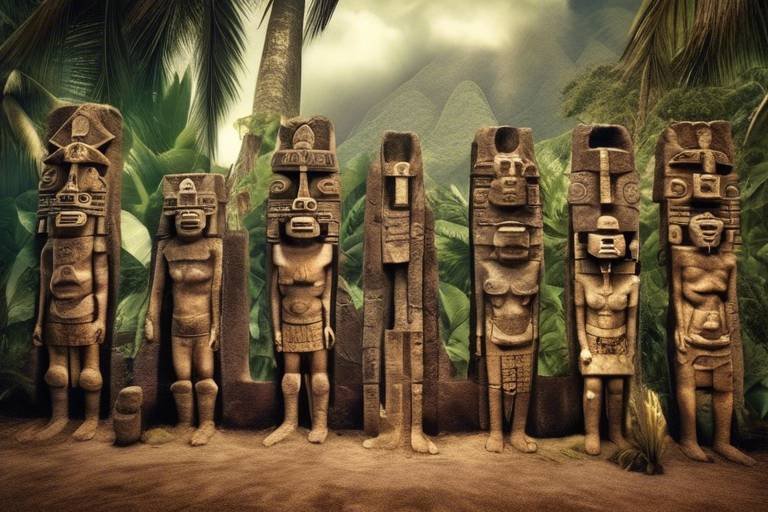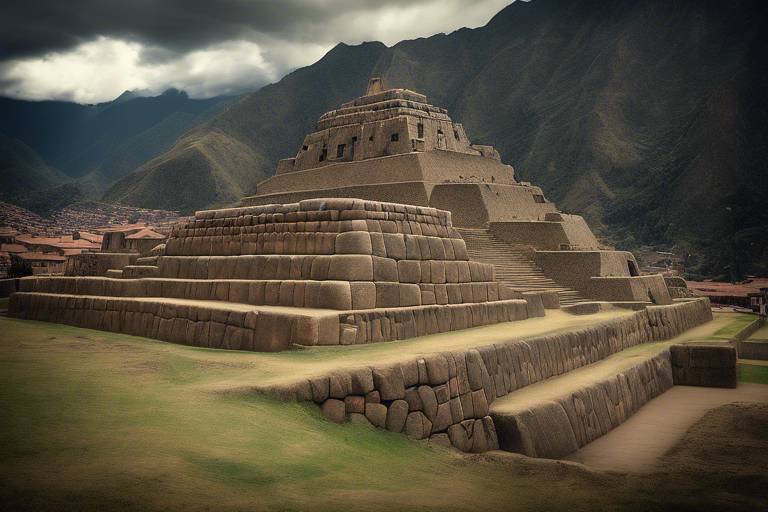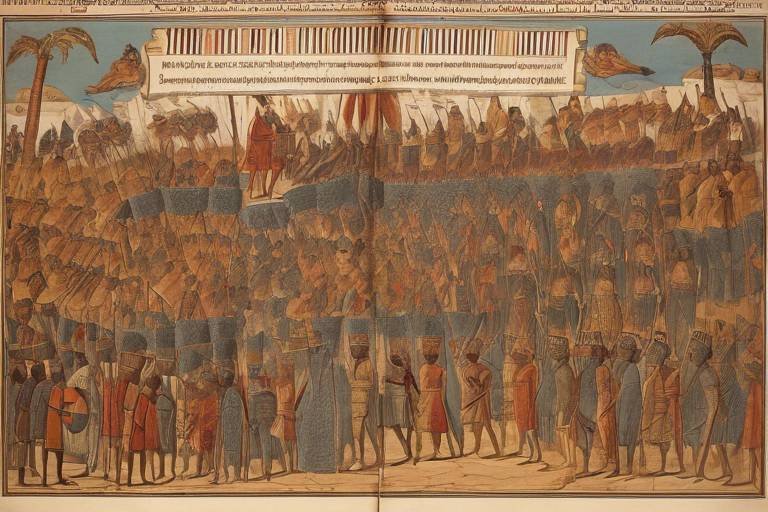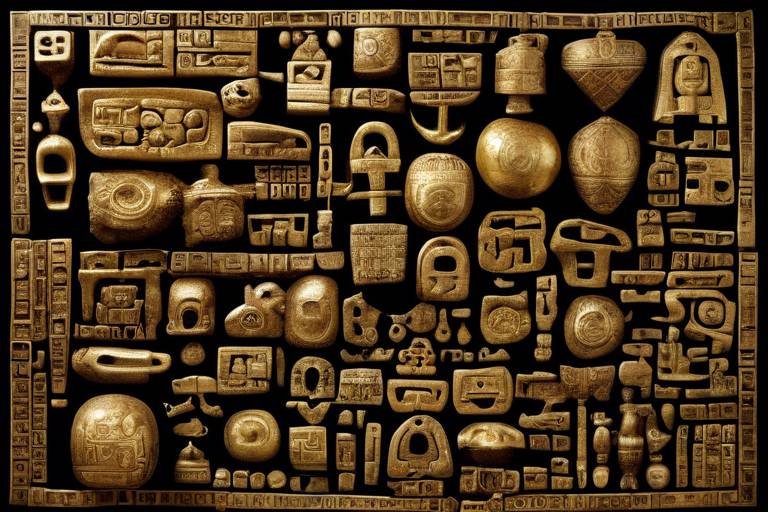The Cultural Riches of the Silla Kingdom - A Lost Era
The Silla Kingdom, a lost era shrouded in mystery and grandeur, holds a treasure trove of cultural riches waiting to be unveiled. This ancient kingdom, nestled in the heart of the Korean Peninsula, stands as a testament to a bygone era of glory and sophistication. From its historical significance to its architectural wonders, the Silla Kingdom beckons us to explore its legacy and unravel the secrets of a forgotten time.
As we journey back in time to the days of the Silla Kingdom, we are met with a tapestry of history woven with tales of conquest and unity. Emerging as a dominant power in ancient Korea, the Silla Kingdom's unification of the peninsula marked a pivotal moment in Korean history, shaping the political landscape and setting the stage for centuries to come.
Amidst the tumultuous winds of history, the Silla Kingdom's artistic achievements shimmer like precious gems, reflecting the kingdom's cultural prowess and artistic sophistication. From intricate gold crowns to delicate pottery and mesmerizing Buddhist sculptures, the art forms of the Silla period speak volumes about the kingdom's dedication to beauty and craftsmanship.
Architectural wonders stand as silent sentinels of the Silla Kingdom's glory, with the Bulguksa Temple and Seokguram Grotto standing as testaments to the kingdom's architectural ingenuity and religious fervor. These majestic structures not only showcase the kingdom's mastery of construction but also serve as beacons of spiritual devotion.
Religion, a cornerstone of Silla society, played a pivotal role in shaping the kingdom's culture and values. Buddhism, with its profound influence, led to the construction of temples and pagodas that dotted the Silla landscape, leaving an indelible mark on the kingdom's spiritual identity.
The burial practices of the Silla elite offer a glimpse into the kingdom's social hierarchy and spiritual beliefs. Elaborate tomb designs, precious burial goods, and a deep-rooted belief in the afterlife underscore the Silla Kingdom's reverence for the departed and the mysteries of the beyond.
Technological advancements during the Silla period showcased the kingdom's scientific achievements and intellectual progress. From advancements in metalworking to pottery techniques and astronomical knowledge, the Silla Kingdom stood at the forefront of innovation and discovery.
Embarking on diplomatic ventures, the Silla Kingdom forged ties with neighboring countries, engaged in trade networks, and fostered cultural exchanges that shaped East Asian geopolitics. The kingdom's influence reverberated across the region, leaving a lasting impact on international relations.
Today, the legacy of the Silla Kingdom lives on in modern Korea, a testament to the enduring power of culture and heritage. From traditional customs to artistic expressions, the Silla Kingdom's influence permeates contemporary Korean society, serving as a reminder of a lost era that continues to inspire and captivate.

Historical Significance of the Silla Kingdom
The Silla Kingdom holds a paramount place in the annals of Korean history, marking a significant era of cultural and political evolution. Rising to power in the early 1st century, Silla gradually expanded its influence, eventually achieving the monumental feat of unifying the Korean Peninsula under its rule. The kingdom's strategic alliances and military prowess played a pivotal role in shaping the region's geopolitical landscape, establishing Silla as a dominant force in ancient Korea.
At the heart of Silla's governance was a sophisticated political structure characterized by a centralized monarchy and a hierarchical system of nobility. This system not only facilitated effective administration but also fostered stability and continuity within the kingdom. The Silla rulers, known for their diplomatic acumen and strategic vision, navigated complex power dynamics to consolidate their authority and ensure the kingdom's longevity.
Moreover, Silla's contributions to Korean history extend beyond its military and political achievements. The kingdom's embrace of Buddhism, introduced in the 6th century, marked a transformative period in Korean religious and cultural history. The propagation of Buddhist teachings and the construction of temples and pagodas underscored Silla's commitment to spiritual enlightenment and the preservation of sacred traditions.
In essence, the historical significance of the Silla Kingdom lies not only in its territorial expansion and political dominance but also in its enduring legacy as a beacon of cultural refinement and artistic innovation in ancient Korea.

Artistic Achievements of the Silla Kingdom
The stand as a testament to the kingdom's cultural richness and creative prowess. During the Silla period, artists and craftsmen produced exquisite works of art that continue to captivate audiences to this day. One of the most renowned artistic creations of the Silla Kingdom is the intricate gold crowns that were crafted for royalty. These ornate crowns, adorned with delicate patterns and intricate designs, symbolize the kingdom's wealth and artistic sophistication.
In addition to gold crowns, the Silla Kingdom excelled in pottery production, creating vessels of exceptional beauty and craftsmanship. Silla pottery is known for its elegant forms, refined glazes, and intricate decorations, showcasing the skill and artistry of Silla potters. The kingdom's pottery not only served practical purposes but also reflected the aesthetic sensibilities of the time.
Furthermore, the Silla Kingdom was a hub of Buddhist sculpture production, producing magnificent statues that embody the spiritual beliefs and artistic ideals of the period. Buddhist sculptures from the Silla era are characterized by their serene expressions, graceful poses, and meticulous detailing, conveying a sense of divine beauty and transcendence.
These artistic achievements of the Silla Kingdom not only demonstrate the kingdom's mastery of various art forms but also reflect its cultural sophistication and aesthetic sensibilities. The legacy of Silla art continues to inspire and awe audiences around the world, preserving the kingdom's artistic heritage for future generations to appreciate and admire.

Architectural Wonders of the Silla Kingdom
The Silla Kingdom, known for its architectural wonders, left a lasting legacy in the history of Korea. Among the most remarkable structures are the Bulguksa Temple and the Seokguram Grotto. The Bulguksa Temple, a UNESCO World Heritage site, stands as a testament to the kingdom's architectural ingenuity and Buddhist influence. Its intricate design and meticulous craftsmanship showcase the Silla people's dedication to both religious devotion and artistic expression.
Similarly, the Seokguram Grotto, an artificial stone temple, houses a magnificent granite Buddha statue. This architectural marvel exemplifies the Silla Kingdom's commitment to creating sacred spaces that harmonize with the natural landscape. The grotto's intricate carvings and serene atmosphere reflect the kingdom's reverence for Buddhism and its pursuit of spiritual enlightenment.
Moreover, the Silla Kingdom's architectural achievements extended beyond temples and grottos. The kingdom's capital city of Gyeongju boasted a sophisticated urban planning system, with intricate palaces, fortresses, and royal tombs dotting the landscape. These structures not only served practical purposes but also symbolized the power and prestige of the Silla rulers.
Overall, the architectural wonders of the Silla Kingdom stand as a testament to the kingdom's cultural richness and artistic sophistication. From religious temples to royal palaces, these structures continue to inspire awe and admiration, showcasing the enduring legacy of the Silla civilization in modern Korea.

Religious Influence in the Silla Kingdom
Religious influence in the Silla Kingdom was profound and far-reaching, shaping the very fabric of society and culture. Buddhism played a pivotal role in the kingdom, with the construction of temples and pagodas serving as physical manifestations of spiritual devotion. These religious structures not only served as places of worship but also as centers of learning and artistic expression, reflecting the kingdom's commitment to both faith and creativity.
The adoption of Buddhism in the Silla Kingdom had a transformative effect on its people, influencing their beliefs, values, and daily practices. Buddhist teachings permeated all aspects of life, guiding individuals in their moral conduct and spiritual pursuits. The presence of Buddhism in Silla society fostered a sense of community and shared purpose, uniting people under a common faith and set of values.
One of the most notable expressions of religious influence in the Silla Kingdom was the creation of intricate Buddhist sculptures and artwork. Skilled artisans crafted exquisite statues and paintings, imbuing them with spiritual significance and beauty. These artistic masterpieces not only served as objects of veneration but also as reflections of the kingdom's cultural sophistication and artistic prowess.
Furthermore, the architectural landscape of the Silla Kingdom was greatly influenced by Buddhism, with the construction of temples, pagodas, and monastic complexes dotting the countryside. These structures not only provided spaces for religious practices but also served as symbols of the kingdom's devotion to the Buddhist faith. The intricate carvings, ornate decorations, and serene surroundings of these religious sites reflected the kingdom's reverence for the divine and its commitment to spiritual enlightenment.
In conclusion, the religious influence in the Silla Kingdom was a driving force behind its cultural development and societal cohesion. Buddhism not only shaped the kingdom's artistic expressions and architectural achievements but also played a central role in defining its values and identity. The legacy of Buddhism in the Silla Kingdom endures to this day, serving as a testament to the enduring power of faith and spirituality in shaping human history.

Burial Practices of the Silla Kingdom
The burial practices of the Silla Kingdom offer a fascinating glimpse into the beliefs and customs of this ancient society. The elite members of Silla society were laid to rest in elaborate tombs, reflecting their status and importance. These tombs were often adorned with intricate carvings and decorations, showcasing the wealth and power of the deceased. Additionally, burial goods such as pottery, jewelry, and weapons were placed in the tombs to accompany the deceased into the afterlife. The Silla people believed in an afterlife where the spirits of the deceased continued their existence, hence the careful preparation of the tombs and inclusion of items for the journey beyond.
One of the most notable aspects of Silla burial practices is the unique tomb design. The tombs were often shaped like keyholes, with a main chamber for the body and a separate chamber for burial goods. These tomb structures were carefully constructed and symbolized the transition from earthly life to the afterlife. The intricate designs and layouts of the tombs reflect the spiritual beliefs and reverence for the deceased held by the Silla people.
Furthermore, the burial practices of the Silla Kingdom also highlight the social hierarchy within the society. The grandeur and scale of the tombs varied depending on the status of the individual being buried. Higher-ranking officials and nobles were interred in larger and more ornate tombs, while commoners had simpler burial arrangements. This distinction in burial practices underscores the stratified nature of Silla society and the importance placed on social status and rank.
In addition to tomb design and burial goods, the Silla Kingdom's burial practices also included rituals and ceremonies to honor the deceased. These rituals often involved offerings of food, drink, and incense to accompany the departed on their journey to the afterlife. The Silla people believed in maintaining a connection with their ancestors, and these burial rituals served as a way to show respect and ensure the well-being of the deceased in the spiritual realm.

Technological Advancements in the Silla Kingdom
During the Silla Kingdom, remarkable technological advancements played a crucial role in shaping the kingdom's progress and influence. One of the key areas of technological innovation was in metalworking, where Silla artisans demonstrated exceptional skill in crafting intricate metal objects. The mastery of metalworking techniques allowed for the creation of exquisite artifacts, such as ornate jewelry, ceremonial weapons, and everyday tools, showcasing the kingdom's craftsmanship and artistic flair.
Additionally, the Silla Kingdom made significant advancements in pottery techniques, producing a wide range of ceramic vessels that were both functional and aesthetically pleasing. Silla potters developed sophisticated methods for shaping and firing pottery, resulting in durable and finely decorated pieces that served practical purposes as well as artistic expression. The intricate designs and vibrant colors of Silla pottery reflected the kingdom's dedication to excellence and innovation in the field of ceramics.
Furthermore, the Silla Kingdom demonstrated a keen interest in astronomy and scientific knowledge, leading to advancements in astronomical observations and calculations. Silla astronomers studied the movements of celestial bodies, developed calendars based on lunar and solar cycles, and made important contributions to the understanding of the universe. Their expertise in astronomy not only enriched their cultural and religious practices but also contributed to the kingdom's intellectual legacy and academic achievements.
In conclusion, the technological advancements of the Silla Kingdom encompassed a wide range of disciplines, from metalworking and pottery to astronomy and scientific inquiry. These innovations not only enhanced the material culture of the kingdom but also reflected the intellectual curiosity and ingenuity of its people. The legacy of Silla's technological achievements continues to inspire admiration and fascination, underscoring the kingdom's enduring influence on Korean history and culture.

International Relations of the Silla Kingdom
During its reign, the Silla Kingdom maintained intricate diplomatic ties with neighboring countries, playing a pivotal role in the East Asian geopolitical landscape. Through strategic alliances and cultural exchanges, Silla established itself as a key player in regional affairs, fostering both cooperation and competition with other states.
One of the defining aspects of Silla's international relations was its extensive trade networks, which facilitated the exchange of goods, ideas, and technologies across borders. The kingdom's position on the Korean Peninsula allowed it to serve as a crucial hub for maritime trade, connecting East Asia with the wider world.
Furthermore, Silla's engagement in cultural diplomacy helped promote mutual understanding and influence among different civilizations. The kingdom's adoption of foreign artistic styles, religious practices, and political systems enriched its own culture while also leaving a lasting impact on its neighbors.
Through diplomatic marriages, gift exchanges, and official missions, Silla solidified its diplomatic relations with countries such as China and Japan, fostering both cooperation and rivalry. These interactions not only shaped Silla's foreign policy but also influenced the cultural development of the entire region.
In essence, the international relations of the Silla Kingdom were characterized by a delicate balance of power, economic interests, and cultural exchanges, highlighting the kingdom's significance as a bridge between different civilizations in ancient East Asia.

Legacy of the Silla Kingdom in Modern Korea
The legacy of the Silla Kingdom continues to resonate in modern Korea, shaping the country's cultural landscape and national identity. The rich heritage left by the Silla Kingdom is evident in various aspects of contemporary Korean society, from traditional customs to artistic expressions.
One of the most prominent legacies of the Silla Kingdom is its influence on Korean art and architecture. The intricate designs and craftsmanship seen in Silla artifacts have inspired modern Korean artists and architects, contributing to the preservation of traditional artistic techniques and styles.
Furthermore, the cultural traditions established during the Silla period, such as the practice of Seon meditation in Buddhism, continue to be an integral part of Korean spiritual life. The teachings of Buddhism, which flourished during the Silla era, have left a lasting impact on Korean philosophy and ethics.
In addition to art and religion, the Silla Kingdom's legacy is also evident in the preservation of historical sites and artifacts. Efforts to safeguard Silla relics, such as the Bulguksa Temple and the Cheomseongdae Observatory, highlight the importance of preserving the kingdom's cultural heritage for future generations.
Moreover, the Silla Kingdom's emphasis on diplomacy and international relations has influenced modern Korea's approach to foreign affairs. The kingdom's history of diplomatic exchanges and cultural diplomacy serves as a model for contemporary Korean engagement with the global community.
Overall, the legacy of the Silla Kingdom serves as a reminder of Korea's rich historical past and the enduring impact of ancient civilizations on modern society. By honoring and preserving the cultural heritage of the Silla Kingdom, Korea pays tribute to its roots and celebrates the legacy of one of its most illustrious historical periods.
Frequently Asked Questions
- What was the significance of the Silla Kingdom in Korean history?
The Silla Kingdom played a crucial role in ancient Korea, emerging as a dominant power and unifying the Korean Peninsula. Its political structure and contributions to Korean history shaped the region's development.
- What are some notable artistic achievements of the Silla Kingdom?
The Silla Kingdom was known for its exquisite art forms, including intricate gold crowns, pottery, and Buddhist sculptures. These artistic creations reflected the kingdom's cultural sophistication and artistic prowess.
- Can you explain the architectural wonders of the Silla Kingdom?
The Silla Kingdom boasted impressive architectural marvels such as the Bulguksa Temple and Seokguram Grotto, showcasing the kingdom's architectural ingenuity and deep religious devotion.
- How did Buddhism influence the Silla Kingdom?
Buddhism had a profound impact on Silla society, leading to the construction of temples, pagodas, and shaping the kingdom's culture and values. It played a significant role in the kingdom's spiritual and social life.
- What were the burial practices of the Silla Kingdom?
The Silla elite had elaborate burial customs, including specific tomb designs, burial goods, and beliefs in the afterlife. These practices offer insights into the kingdom's social hierarchy and spiritual beliefs.
- What technological advancements were made during the Silla period?
The Silla Kingdom made significant technological innovations in areas such as metalworking, pottery techniques, and astronomical knowledge. These advancements highlighted the kingdom's scientific achievements and intellectual progress.
- How did the Silla Kingdom engage in international relations?
Silla had diplomatic ties with neighboring countries, engaged in trade networks, and cultural exchanges, showcasing its influence in East Asian geopolitics and its role in regional affairs.
- What is the legacy of the Silla Kingdom in modern Korea?
The legacy of the Silla Kingdom continues to shape contemporary Korean society, influencing cultural traditions, artistic expressions, national identity, and ongoing efforts to preserve its heritage.



